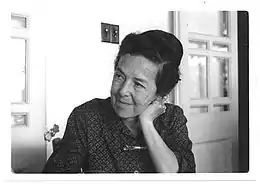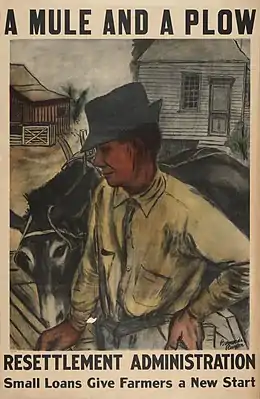Bernarda Bryson Shahn
Bernarda Bryson Shahn (March 7, 1903 – December 13, 2004)[1] was an American painter and lithographer. She also wrote and illustrated children's books including The Zoo of Zeus and Gilgamesh. The renowned artist Ben Shahn was her "life companion" and they married in 1969, shortly before his death.[1]
Bernarda Bryson Shahn | |
|---|---|
 Bernarda Bryson Shahn in 1960 | |
| Born | Bernarda Bryson March 7, 1903 |
| Died | December 13, 2004 (aged 101) Roosevelt, New Jersey, United States |
| Known for | Painting, Lithography, Illustration |
| Spouse(s) | Ben Shahn (m. 1935; 3 children) |
Personal life

Bernarda Bryson was born in Athens, Ohio, where her father owned the Athens Morning Journal and her mother was a Latin professor.[2] Both of her parents were politically active and liberal.[2] In Ohio she studied art, including etching, and art history at several schools including Ohio University, Ohio State University, and the Cleveland School of Art, and learned lithography from a friend.[2] She married young, divorced, and then worked for a newspaper in Columbus, the Ohio State Journal, writing about art news, and teaching printmaking for the museum school at the Columbus Museum of Art.[1][2] On a trip to New York in 1932 (or 1933)[1] to interview Diego Rivera, during the production of his Rockefeller Center murals, she met his assistant Ben Shahn.[3] After moving to New York shortly after completing the interview, Bryson reconnected with Shahn and they moved to Washington, DC.[2] Bryson and Shahn had three children together and eventually settled in Roosevelt, New Jersey.[1] She died at her home in Roosevelt at the age of 101 on December 13, 2004.[1]
Career
Already a trained printmaker, Bryson worked for the Depression-era Resettlement Administration, later part of the Farm Security Administration on a project with Shahn in the 1930s to document rural life. Her lithographs from this series were first printed in the studio she and Shahn established in Washington for the Resettlement Administration and published in full in 1995 as The Vanishing American Frontier.[1][2] In 1939, Bryson and Shahn produced a set of 13 murals for the Treasury Department Art Project's Section of Fine Arts entitled Resources of America inspired by Walt Whitman's poem "I See America Working" and installed at the United States Post Office-Bronx Central Annex.[4] Bryson worked primarily as an illustrator beginning in the 1940s, producing works for Harpers as well as Life, Seventeen, and Scientific American, and later for several children's books.[1][2] She continued painting throughout her life in a figurative style often with references to Classical mythology, and her worked was exhibited in solo shows at galleries in New York and New Jersey.[1] Her paintings are owned by collections including the Whitney Museum of Art.[1]
Further reading
References
- Fox, Margalit (December 16, 2004). "Bernarda Bryson Shahn, Painter, Dies at 101". The New York Times. Archived from the original on August 22, 2013. Retrieved February 14, 2011.
- Kirwin, Liza. Oral History Interview with Bernarda Bryrson Shahn. "Archives of American Art." 29 April 1983. https://www.aaa.si.edu/collections/interviews/oral-history-interview-bernarda-bryson-shahn-11655 Archived 2019-04-17 at the Wayback Machine
- Fitzgerald, Jean. "A Finding Aid to the Bernarda Bryson Shahn Papers, 1872-2004". Archives of American Art. Archived from the original on April 2, 2015. Retrieved March 29, 2013.
- Framberger, Donald J.; Joan R. Olshansky & Elizabeth Spencer-Ralph (September 1979). "National Register of Historic Places Registration: Bronx Central Annex-U.S. Post Office". New York State Office of Parks, Recreation and Historic Preservation. Archived from the original on 2012-10-15. Retrieved 2010-10-01.
External links
- A Finding Aid to the Bernarda Bryson Shahn Papers, 1872-2004, bulk 1904-2004, in the Archives of American Art: Jean Fitzgerald
- Oral history interview with Bernarda Bryson Shahn, 1983 Apr. 29: Archives of American Art
- Bernarda Bryson at Library of Congress Authorities, with 50 catalog records